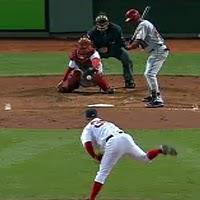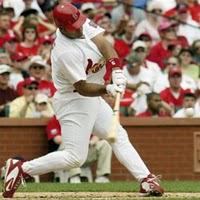
If you want to keep moving up, you
better learn how to handle this pitch.
All this being said, there are a few things hitters can do to improve on their low-ball hitting. Here are just a few:

Back knee drives down towards the
height of the front calf.
Exaggerate. One of the best ways to train for something is to exaggerate the activity or behavior you want to train for. When some runners train for the mile, they will consistently run more than a mile in their training so that a one-mile race isn’t so tough. Hitting works the same way. If you want to become better at hitting the low pitch, train yourself to hit a very low pitch. If you train to successfully hit a pitch at the shins, a low strike at the knees doesn’t seem so tough anymore. Set the tee as far down as it can go. Many tees are not constructed to accommodate this so you’ll have to create an alternative. Another post in the near future will show what I do with my players to accomplish this.

Back knee down once again.
Knee to calf. Mechanically speaking, there are a number of things that hitters must do to properly hit any pitch in the strike zone. There is one, however, that stands out in my mind in terms of being able to address the low pitch. It involves driving your back knee to the calf of the front leg. Many hitters, especially those who prefer to stand very tall in their initial batting stance, have a tough time getting the barrel of the bat to low pitches. They end up reaching for the pitch and hit it off the end of the bat or miss it completely. When players do this, both their knees tend to end up at the same height at the point of contact. Driving the back knee down towards the calf of the front leg lowers the body (and the barrel) enabling the good part of the bat to get to the ball. (both photos show this) They “drive” to the low pitch instead of just reaching for it.
